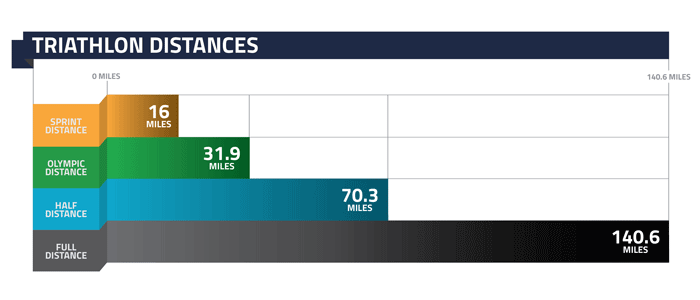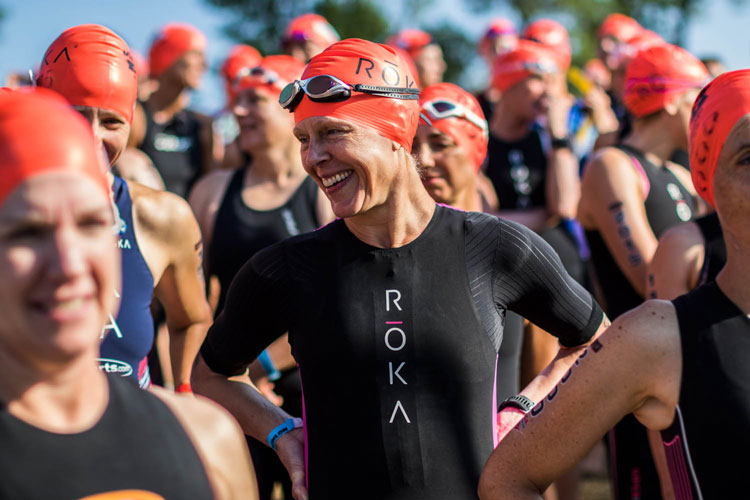You Know You Want to Tri It
Three Sports, One Finish Time.
It might sound hard core, but if you know how to swim, can ride a bike and can run, even casually, then completing a triathlon is totally within your grasp. The sport is incredibly beginner-friendly, welcoming and utterly rewarding.
The modern triathlon is almost 43 years old, with its first organized event taking place in 1974 at Mission Bay in San Diego, California. There were a total of 46 participants who paid the $1 entry fee. Prices may have gone up, but nowadays, you can find triathlon events in every state, and almost every country, at almost any distance. Most everyone chooses to start with a sprint, super sprint or relay triathlon, where distances for each segment are short.
Why Try a Tri Distances & Disciplines Race Day Tips Set up for success triathlon lingo
Why Try a Tri?
If you’re reading this, you’re tri-curious. Maybe you’ve been running a while, but are looking for some variety. Maybe you swam in school and miss the competition. Or maybe you love riding your bike for miles on end, but would like some company. Triathlon can do all of that for you, and while triathlons are still competitions, athletes (even the pros) are incredibly supportive, encouraging and motivating. Triathlons themselves are often weekend events, with a carnival-like atmosphere and family friendly fun.
For your fitness, triathlon training is terrific low-impact cross-training. It’s a great way to modify your training if the pounding of running is starting to bother your joints. By spreading your effort over three disciplines, you’ll minimize getting burned out, will improve flexibility and endurance, and will have found a sport that you’ll enjoy for a lifetime. What’s more, beginners can see huge improvements in their first couple of seasons, and that’s a big motivational boost!
While bike shops are bursting with fancy bicycles, you can race a triathlon with minimal investment. For your first few events, any bike will do, along with a few other items you probably already own, or can borrow.
Go Short or Long
There really is a triathlon for everyone. You’ll see four main distances, along with a ton of variations. For instance, super sprints are even shorter and are gaining in popularity.
There is no rhyme or reason to why some distances are expressed in miles and others in kilometers or meters. Call it a crazy melting pot of imperial and metric!
Here are the most popular event distances.

Many events also host variations on the basic distances. You’ll also find a variety of disciplines to suit your interests.
Aquabike
You’ll compete just the swim and bike portions and head to the finish. This is a great option for those who can’t or just don’t like running.
Duathlon
Still three segments, but with a run-bike-run order.
Aquathlon
Just the swim and run, with no cycling.
Off-Road/Cross Country
Think mountain biking and trail running instead of paved roads.
Relay
These allow a team of two or three to compete.
Winter Triathlon
Running, mountain biking and cross-country skiing — all performed on snow.
Paratriathlon
Many races have a special category, or entire special events, for athletes with disabilities.
How It All Works on Race Day
Triathlon involves a fair amount of logistics, planning and packing, but most race organizers do their best to make things as simple and smooth as possible.
Checking in/packet pick-up
Before the race, you’ll need to pick up your race number, swim cap, stickers for your bike and helmet, and gear check bag (to store your post-race clothing). Some races require that you check in the day before the race, while others let you do it all on race day. You’ll be storing your bike (called racking) and gear in a central “transition” area.
You’re going to swim first
You might swim in a lake, river, ocean or pool. Some may have you start in the water, lining up and treading water until the horn goes off. Or you might start on a beach and run into the water. Others have you jumping feet-first off the pool deck, a dock, barge or even a ferry (try it — it’s fun!). Most people will be swimming freestyle (or crawl) stroke, but you’re allowed to swim any stroke you like. You’ll be following a course, swimming from one large buoy to the other until you finish back on the beach or dock.
Transition to the bike (T1)
After you finish the swim course, walk or jog to the transition area to get your bike. You’ll be barefoot, so watch your step! Change into your shoes, fasten on your helmet and walk your bike to the “bike out,” where you’ll be able to start riding after you pass the “mount line.”
Transition to the run (T2)
You’ll be directed by volunteers to the “bike in,” and instructed when to dismount your bike and walk it back to your spot in the transition area. Ditch your helmet, change to your running shoes (if you used cycling shoes on the bike), fasten on your race number, and head out for the run!
The finish line
Once you’ve crossed the finish line after the run, you’re done. Time to celebrate! After you’ve refueled and reveled in your awesomeness, you’ll need to head back to the transition area, pack up your gear, and retrieve your bike.
Setting Yourself up for Success: Practice and Learn!
- Do some open water swim practice. It’s very different from pool swimming, and new triathletes often have anxiety about the swim.
- Practice transitions. Check out YouTube for tips and changing to each segment seamlessly. Time spent in transition counts as part of your total race time.
- Practice going from bike to run. Running directly after cycling feels very strange.
- Find a club or buddy. Triathlon is better with friends! Do some Googling to find a local club.
- Read the athlete guide. Every race has one, and every race is different. It’s your responsibility to understand the schedule of events and rules.
- Go to the athlete meeting. This is a great way to get a feel for the course conditions and anything weird that could surprise you on race day. Plus, you can ask questions.
- Walk through swim out to transition, bike out, bike in to run. Before the race, make sure you know where you’ll be entering and exiting the transition area.
Triathlon Lingo
Aerobars: These special handlebars extend out from your bike and give you a place to rest your elbows. They offer a more aerodynamic, tucked position than can help you achieve faster bike times.
Age-grouper: Amateur athletes are called age-group athletes, competing with others in 5-year age and gender groups. Race age is determined by one’s age on Dec. 31 of the race year.
Bodymark: Race number on arm and age on calf with temporary tattoo or black marker.
Brick: Combination workouts that include two disciplines back to back with minimal or no interruption, such as a bike followed by a run.
Clydesdale/Athena: Race categories for men over 220 pounds and women over 165 pounds.
Cooldown: Physical activity done after a workout or competition to loosen muscles and rid the body of lactic acid.
Cross-train: To engage in various sports or exercises especially for well-rounded health and muscular development.
DNS/DNF: Did Not Start and Did Not Finish.
Drafting: Swimming behind a slightly faster person can save your energy, and is allowed. But drafting on the bike course — where you closely follow another athlete to reduce wind resistance — is only allowed in draft-legal races. In non-drafting races, participants must keep at least three bike lengths of clear space between themselves and the cyclist in front of them. If you move into the drafting zone, a rectangular area surrounding each bicycle, you must pass within 15 seconds.
Mount line: You can’t get on your bike until you cross this line.
Multisport: A sport consisting of more than one discipline, including triathlon, duathlon, aquathlon, aquabike, off-road triathlon and winter triathlon.
PR/PB: Personal record and personal best. Good for you!
Racking your bike: Placing your bike in the transition area on provided racks.
Sighting: Follow the swim course by lifting your eyes out of the water every stroke or two to see where you are in relation to the course buoys.
Speed laces: Elastic/bungee laces for your running shoes to save time tying them.
Swim waves: Based on gender, age and/or speed, you’ll start the swim with a subset of people, with your own starting horn. This is to space out athletes on the course.
Timing chip: You’ll wear a chip, attached to an ankle strap, through the whole race to track your time.
Transition (T1 + T2): Areas where your bike and gear are stored throughout the race. You’ll have an assigned spot. After each leg of the race, athletes return to transition to swap equipment before heading back onto the race course.
Trisuit: These are shorts and a top, or a one-piece style, that you wear through the entire race.
TT bike/tri bike: Special road bikes made for triathlon racing, with flat handlebars and a set of aerobars.
Warm-up: To engage in activity before a race or workout. Warming up has a wide range of physiological and psychological benefits.
Wetsuit: A close-fitting suit made of rubber and worn by swimmers when they are in cold water to keep their bodies warm. Wetsuits also make you more buoyant and faster. Find wetsuit temperature rules here.


